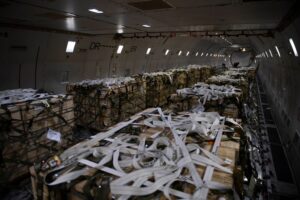The Pentagon is considering including new types of weapons in future security equipment packages to Ukraine, including longer-range systems, Deputy Defense Secretary Kathleen Hicks said Tuesday.
Hicks did not specify new capabilities that could be included with future deliveries to support Ukraine in its ongoing fight against Russia’s invasion of the country, while noting a new equipment aid package may be announced soon.

“We will continue to look at the types of capabilities that the Ukrainians are asking for, in terms of how to give them a little more range and distance. Until those packages are announced I don’t want to get in front of those. Those are presidential decisions but we are moving those packages very quickly and I think you’ll see more come out in the coming days,” Hicks told the Defense Writers Group.
The U.S. has provided more than $2 billion in security assistance to Ukraine in the last year and $1.7 billion since the start of the invasion, to include a $300 million security equipment package announced earlier in April (Defense Daily, April 3).
The latest military aid package is being provided through the Ukraine Security Assistance Initiative program where weapons will be procured from industry rather than being drawn from existing stockpiles, and includes laser-guided rocket systems, armored Humvees, AeroVironment’s [AVAV] Switchblade and Puma drones, counter-UAS capabilities, ammo, night vision devices, thermal imagery systems, tactical secure communications systems, machine guns, commercial satellite imagery services and medical supplies.
“I’ve never seen anything like it in terms of the ability to identify [equipment], work with allies and partners, work with industry, work within the services and then move that capability forward and get it into Ukraine. It’s just an incredibly impressive set of work,” Hicks said. “Are we looking at a wide range of systems in doing that? Yes. I will say we still see areas like artillery rounds, and not just Stingers or Javelins, but other kinds of ammunition rounds as being incredibly important. You can move a lot of that. We will continue to do so. We know the intel support that we provide has been vital. The Ukrainians have been very clear about that publicly as well. We will continue to do that.”
Hicks said sustaining the current level of equipment transfer to Ukraine will require continued work with allies and partners to identify their potential capabilities to be provided, noting 30 nations have transferred military systems to aid Kyiv’s fight.
“We want to make sure we’re working with all of those allies and partners to figure out where there might be some need for backfills for them. Do they have things that they want from our industry? So that’s a whole effort underway with armament directors throughout NATO but [also] beyond NATO,” Hicks said.
Hicks told reporters she was meeting Tuesday with the CEO of Raytheon Technologies [RTX], which builds the Stingers and co-produces the Javelins, as well as holding a larger industry roundtable on Wednesday to discuss production line resiliency with ongoing equipment transfers.
“I’m sure you already know in some specific mission areas, for example, we know we have obsolescence issues and some other items. But we have seen, very patriotically, the numbers of industry performers indicate their willingness to work together and that’s what we’re getting after,” Hick said. “The White House has been very clear that the president is very happy to lean forward on where we think we need help. Congress has done the same. So nothing’s in our way, if you will, we’re just trying to make sure we identify any challenges that we face and then move out on them.”